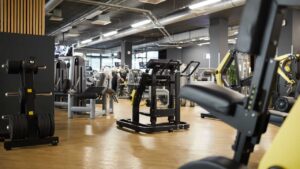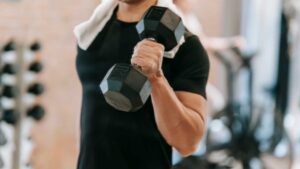Top Lower Body Exercises to Boost Athletic: Lower body strength and power are crucial for athletic performance in almost every sport. Whether it’s sprinting, jumping, or changing directions, your legs provide the foundation for explosive and dynamic movements. A well-structured lower body workout not only improves performance but also reduces the risk of injuries and enhances overall stability and balance. Exercises like squats, lunges, and deadlifts are the cornerstone of any lower body routine, while plyometric and single-leg exercises add a functional and athletic edge. This guide will walk you through the best exercises and techniques to build strength, power, and agility in your lower body, helping you reach your full athletic potential.
1. Top Lower Body Exercises for Explosive Power Development in Athletes
Explosive power is crucial for athletes to perform quick, high-intensity movements like sprints or jumps. Some of the best exercises for developing lower body explosive power include box jumps, broad jumps, and squat jumps. These exercises target your fast-twitch muscle fibers, helping to increase your speed and power output. Strength exercises like squats and deadlifts also play a role in developing foundational strength for explosive movements. By training your legs to generate more force quickly, you’ll improve in sports like football, basketball, and track events.
2. Why Squats are Crucial for Athletic Performance
Squats are one of the most effective exercises for athletes because they target multiple muscle groups, including the quadriceps, hamstrings, glutes, and lower back. They help to build strength, power, and endurance, all of which are essential for athletic performance. Squats also improve joint mobility, especially in the hips and knees, which is vital for better movement efficiency. Regular squatting enhances core stability, making it easier to maintain balance and posture during sports activities. Whether for running, jumping, or agility drills, squats provide a solid foundation for all types of athletic movements.
3. Lunges: An Essential Exercise for Agility and Balance
Lunges are fantastic for improving both agility and balance. This exercise works the major muscles of your legs, including the quads, hamstrings, and glutes, and it also helps stabilize your core. By stepping forward and lowering your body, lunges mimic real-life movements that athletes perform during sports. They also improve your coordination, especially when you do walking lunges or add a twist for rotational movement. Lunges challenge each leg individually, helping to correct imbalances and preventing injury.
4. Building Strong Hamstrings for Enhanced Speed and Endurance
Strong hamstrings are key to improving both your speed and endurance. These muscles play a big role in running, sprinting, and jumping. Hamstrings help you generate more force when pushing off the ground, which translates into faster sprints. Exercises like Romanian deadlifts, leg curls, and glute bridges specifically target the hamstrings, helping to increase strength and flexibility. Strong hamstrings reduce the risk of strains and injuries, allowing you to run and jump longer with less fatigue.
5. The Role of Deadlifts in Athletic Strength Training
Deadlifts are one of the best strength training exercises because they target several muscle groups at once, including the back, legs, and core. This full-body movement helps build foundational strength, which is vital for athletes who need to perform explosive movements. Deadlifts help improve posture, balance, and stability, which can reduce the risk of injury. Additionally, they enhance grip strength, which is important for athletes in contact sports or weightlifting. By including deadlifts in your routine, you can develop a strong base that supports all your athletic movements.
6. Plyometric Exercises to Improve Lower Body Explosiveness
Plyometric exercises, such as box jumps, jump squats, and bounding, are great for improving explosive power in your lower body. These exercises involve quick, powerful movements that activate your fast-twitch muscle fibers, helping you jump higher, sprint faster, and change direction more effectively. Plyometrics not only improve your power output but also help increase coordination, balance, and reaction time. When performed correctly, these exercises can enhance your overall athletic performance and make you more agile in sports.
7. Benefits of Single-Leg Exercises for Injury Prevention
Single-leg exercises, like single-leg squats or lunges, are important for injury prevention because they improve balance and address muscle imbalances. These exercises help each leg work independently, ensuring that both sides of your body are equally strong. This is especially important in sports where one leg may take more load than the other. By improving your stability and strength in each leg, single-leg exercises help reduce the risk of common injuries like ankle sprains or knee problems.
8. How to Target the Glutes for Better Athletic Performance
The glutes are among the most powerful muscles in your body and play a key role in sports performance. Strong glutes help improve running speed, jumping height, and overall agility. Exercises like hip thrusts, glute bridges, and Bulgarian split squats specifically target the glutes. These movements help build strength in the hips, which is essential for explosive power and stability. Strong glutes also help with posture and reduce strain on the lower back, making them important for injury prevention.
9. Best Lower Body Exercises for Sprinting Speed and Acceleration
To increase sprinting speed and acceleration, focus on exercises that build strength and power in the legs. Squats, lunges, and deadlifts help build the foundation of strength needed for sprinting. Plyometric exercises like box jumps and bounds also train your legs for fast, explosive movements. Additionally, exercises that improve ankle and calf strength, such as calf raises, are essential for a stronger push-off during sprints. Combining these exercises will help you run faster and accelerate quicker during your races or training.
10. Incorporating Resistance Bands for Lower Body Strength and Stability
Resistance bands are a simple but effective tool for strengthening the lower body. They add extra resistance to your workouts, making muscles work harder and leading to better strength and stability. Using bands for exercises like squats, leg presses, or side steps helps activate your glutes, hamstrings, and quads. Resistance bands also improve joint stability, which can prevent injuries and improve overall movement control. They’re also portable and can be used for warm-ups or rehabilitation after injuries.
11. Do resistance bands work for legs?
Yes, resistance bands are very effective for strengthening the legs. They provide constant resistance during exercises like squats, lunges, or leg lifts, which helps target key muscles in the legs, such as the quads, hamstrings, and glutes. The tension from the bands makes muscles work harder, leading to better strength and toning. They are also great for improving flexibility and range of motion, especially in the hips and knees. Resistance bands can be a valuable addition to any leg workout routine.
12. How many days a week should I work out legs?
Ideally, you should work out your legs 2 to 3 times a week to see significant strength and power gains. This frequency allows you to target all the major muscle groups in the legs, including the quads, hamstrings, glutes, and calves, while also giving enough rest between sessions. It’s important to allow for recovery to avoid overtraining, which can lead to injuries. If you’re doing high-intensity leg workouts, 2 days a week may be sufficient. However, if your workouts are moderate, 3 days can be effective for building muscle and power.
13. What is the most effective glute exercise?
The most effective glute exercise is the hip thrust. This exercise directly targets the glutes by allowing you to lift a heavy weight while maintaining a proper range of motion. When done correctly, hip thrusts activate the glute muscles more than other exercises like squats or lunges. For beginners, bodyweight glute bridges can be a good starting point. As you progress, you can add weight to increase resistance. Hip thrusts not only strengthen the glutes but also improve hip extension, which is important for sprinting and jumping.
FAQs: Top Lower Body Exercises to Boost Athletic
1. Why are lower body exercises important for athletes?
Lower body exercises build strength, power, and endurance, which are essential for sprinting, jumping, and agility. They also improve balance and reduce the risk of injuries.
2. How often should I train my lower body?
For optimal results, train your lower body 2–3 times per week, allowing enough rest and recovery between sessions to avoid overtraining.
3. Which lower body exercise is best for explosive power?
Plyometric exercises like box jumps, squat jumps, and broad jumps are excellent for developing explosive power.
4. What’s the best exercise to strengthen glutes?
Hip thrusts are one of the most effective exercises for targeting and strengthening the glutes.
5. Can resistance bands help build lower body strength?
Yes, resistance bands are great for activating and strengthening muscles, improving stability, and enhancing range of motion in the lower body.
6. What exercises improve sprinting speed?
Squats, lunges, deadlifts, and plyometric drills like bounding and box jumps are ideal for improving sprinting speed and acceleration.
7. How do single-leg exercises prevent injuries?
Single-leg exercises correct muscle imbalances and improve stability, which reduces the risk of injuries in sports that involve quick direction changes or uneven loads.
8. Are deadlifts necessary for lower body strength?
While not mandatory, deadlifts are highly effective for building overall strength in the legs, back, and core, making them a great addition to your routine.
9. What’s the difference between squats and lunges?
Squats target both legs simultaneously, focusing on overall lower body strength. Lunges work one leg at a time, improving balance, coordination, and functional strength.
10. How can I warm up for a lower body workout?
A good warm-up includes dynamic stretches like leg swings, high knees, and bodyweight squats, as well as activation exercises with resistance bands to prepare your muscles.




